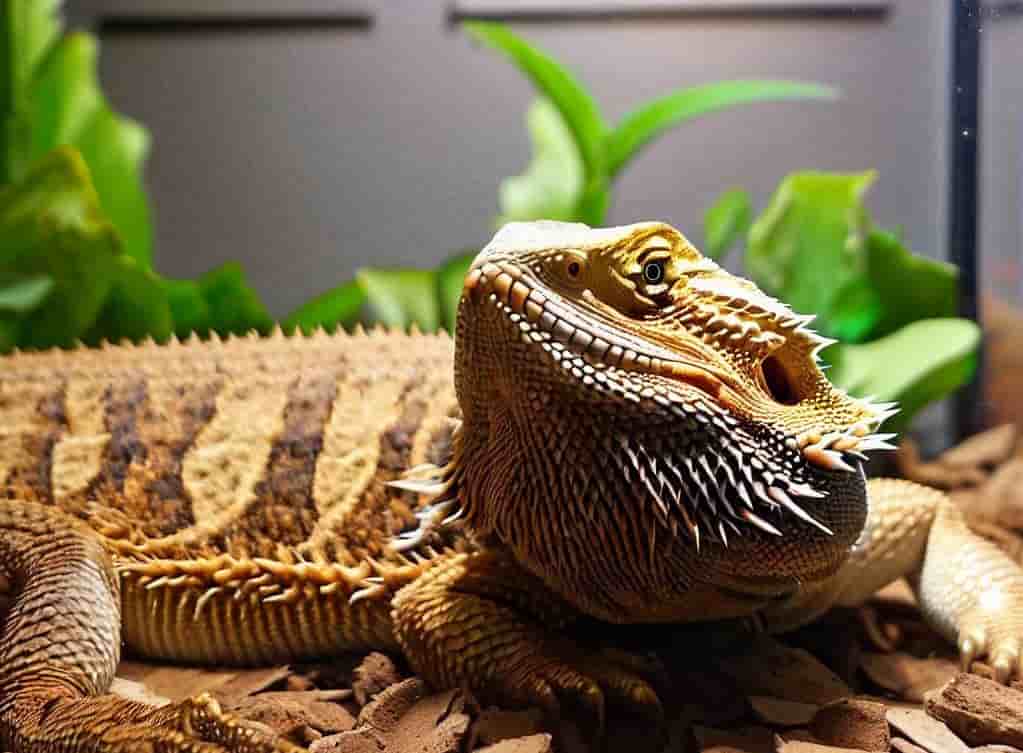Curating a beautiful home for your bearded dragon isn’t just about aesthetics. You can significantly help their livelihood with beneficial additions to their habitat.
Safe plants top the list of such additions as safe plants contribute to your beardie’s well-being, adding an enriching natural element to their habitat.
We’ve curated a list of our top 60 safe plants for bearded dragons (as well as 20 to avoid) to help make it easy for you to enhance their living quarters.
Scroll down and dive in!
Table of Contents
Is It Safe To Put Plants in Bearded Dragon’s Enclosure?
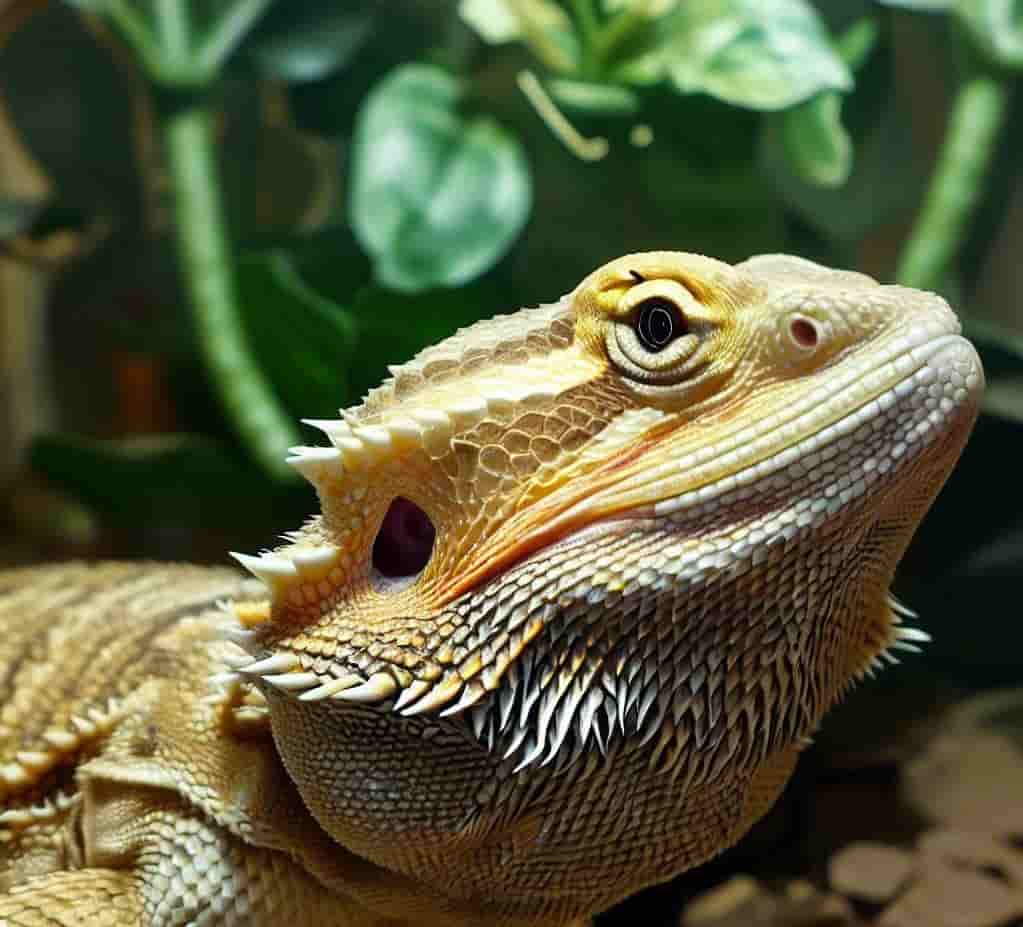
In a nutshell, yes! But there’s a slight catch here. Not all plants for bearded dragon tanks are safe. Your selection should always be intentional, based on a list of edible plants for bearded dragons and non-toxic plants for your pet.
Monitor Your Bearded Dragon’s Interaction With The Plants
Observation is key! Your bearded dragon’s interaction with the plants can reveal much about their safety. Watch for any changes in your dragon’s behavior or health after introducing a new plant. If issues arise, remove the plant immediately.
Best 60 Safe Plants for Bearded Dragons
Roll up your sleeves! It’s time to revamp your bearded dragon’s enclosure. Let’s take you through a comprehensive catalog of live plants for a bearded dragon that you can choose from.
Leafy Plants
Leafy plants are also a great choice for bearded dragon safe plants. They add a vibrant, fresh touch to your bearded dragon’s home. They’re a fantastic addition to any enclosure, and many can serve as delicious treats for your pet.
Arugula (Eruca vesicaria)
Arugula is a peppery, edible leafy green that’s safe for bearded dragons. It’s a great source of vitamins A and C. Plus, its unique flavor might be an interesting addition to your pet’s diet.
Collard Greens (Brassica oleracea var. acephala)
A staple in many bearded dragon diets, collard greens are a safe and nutritious choice. They’re packed with calcium, making them beneficial for your dragon’s bone health.
Kale (Brassica oleracea var. sabellica)
While kale is safe for bearded dragons, it should be given in moderation due to its high oxalate content, which can interfere with calcium absorption. However, its high levels of vitamins A, C, and K make it a worthy addition to your dragon’s diet.
Mustard Greens (Brassica juncea)
Another fantastic leafy green option, mustard greens are a safe and nutritious plant. They’re rich in calcium, fiber, and vitamins, contributing to your bearded dragon’s overall health.
Turnip Greens (Brassica rapa)
Turnip greens are a good source of calcium and vitamin C. Like other greens, they should be chopped into small pieces to make it easier for your dragon to eat.
Endive (Cichorium endivia)
Endive leaves are crunchy, mildly bitter, and absolutely safe for your bearded dragon. They are also high in fiber and low in oxalates, making them a fantastic choice.
Escarole (Cichorium endivia var. latifolium)
Escarole is similar to Endive and provides similar benefits. It’s safe for your dragon and can be an excellent source of nutrients.
Hibiscus (Hibiscus rosa-sinensis)
Believe it or not, your bearded dragon can safely eat hibiscus leaves and flowers. They are packed with nutrients, and most dragons love their taste. Plus, the plant adds a beautiful splash of color to the tank.
Mulberry Leaves (Morus spp.)
Mulberry leaves are not only safe but also highly nutritious for bearded dragons. They contain antioxidants and essential minerals like calcium and iron.
Rosemary (Rosmarinus officinalis)
While not typically a staple in a bearded dragon’s diet, rosemary is safe for them to consume. It also has a strong aroma that could help stimulate your dragon’s senses.
Wheatgrass (Triticum aestivum)
Wheatgrass is a safe plant for bearded dragons. It’s packed with vitamins and nutrients that can benefit your dragon’s health. It’s also a wonderful addition to creating a fresh, green landscape in the enclosure.
Succulent Plants
Succulents make for great live plants for bearded dragon enclosures. They’re hardy, low-maintenance, and come in many fascinating shapes and colors. Let’s take a look at some succulents that can brighten your dragon’s home.
Aloe Vera (Aloe vera)
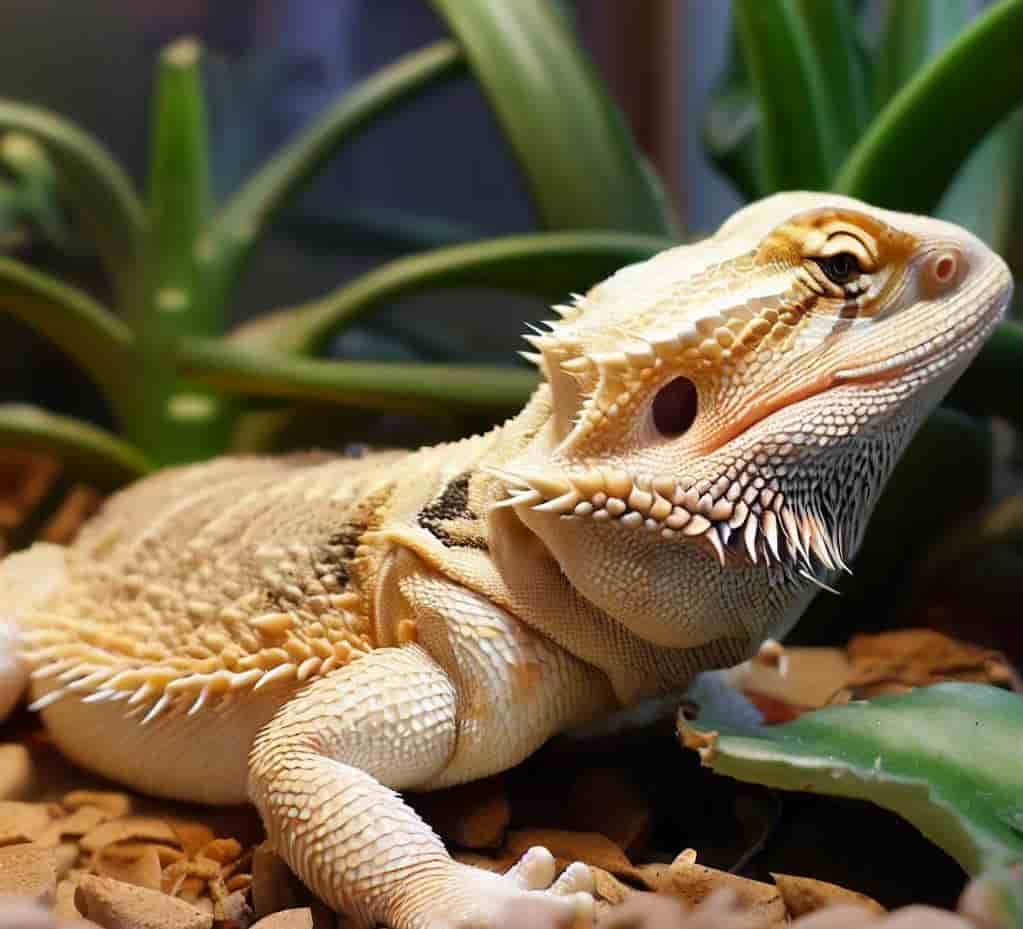
Known for its soothing gel, aloe vera is a safe and easy-to-care-for plant that can thrive in a bearded dragon’s tank. It’s non-toxic if your dragon takes a nibble, and it adds a tropical feel to the enclosure.
Echeveria (Echeveria spp.)
Echeveria is a rosette-forming succulent with beautiful, plump leaves. They are safe for bearded dragons and can survive under the heat lamps. However, ensure they’re not always in direct light to prevent their leaves from burning.
Hens and Chicks (Sempervivum spp.)
A charming addition to your bearded dragon’s environment is the “Hens and Chicks” succulent. Their rosettes come in various colors and textures, creating visual interest. Rest assured; these plants are entirely safe for your bearded dragon.
Portulaca (Portulaca spp.)
Portulaca or moss rose, is another succulent safe for bearded dragons. These plants are heat-tolerant and produce colorful flowers that can add a pop of color to the tank.
Sedum (Sedum spp.)
Sedum, also known as stonecrop, includes a diverse range of succulents. They are safe for your dragon and offer a unique texture and color palette to the environment. They are also pretty tough, withstanding a variety of conditions.
Herbs
Herbs are yet another excellent option for bearded dragon plants. Not only can they provide visual interest to the enclosure, but they are also aromatic and provide a variety of textures and colors. Let’s explore some safe and beneficial herbs for your bearded dragon’s habitat.
Basil (Ocimum basilicum)
Basil, with its vibrant green color and distinct aroma, is safe for bearded dragons. It’s hardy and can withstand the heat, making it a great addition. Plus, if your dragon fancies a nibble, basil leaves provide a good source of calcium and vitamin A.
Catnip (Nepeta cataria)
Surprising as it may be, catnip isn’t just for cats. It’s a safe plant for bearded dragons, too. It’s pretty purple flowers add a touch of color to your pet’s habitat. Catnip is also known for its insect-repelling properties, a bonus in an enclosure.
Chamomile (Matricaria chamomilla)
Chamomile, recognized by its daisy-like flowers, is an excellent calming plant. Though bearded dragons don’t usually eat it, it’s safe if they do. Just remember to remove the flowers once they wilt to maintain a clean enclosure.
Dill (Anethum graveolens)
Dill is a soft, feathery plant that is completely safe for bearded dragons. It’s easy to care for and can give your enclosure a lush, forest-like appearance. Dill provides a pleasant aroma, and if your dragon samples it, it offers a tasty treat.
Lemon Balm (Melissa officinalis)
Lemon balm is a perennial herb with a refreshing, citrusy scent. Safe for your bearded dragon, it also has a calming effect on them. Plus, its beautiful tiny white flowers are a delightful sight to see.
Marjoram (Origanum majorana)
A close relative to oregano, Marjoram is a safe and beneficial herb for bearded dragons. Its compact growth habit adds structure to the habitat and has a pleasant aroma that can help mask any odors in the enclosure.
Oregano (Origanum vulgare)
Oregano is not just for cooking; it’s an excellent herb for your dragon’s enclosure. Its thick, bushy growth can give your bearded dragon some privacy, and it’s safe if they choose to sample it.
Peppermint (Mentha × Piperita)
Peppermint is a great plant to add some visual interest and a fresh scent to your bearded dragon’s enclosure. The leaves are safe if your bearded dragon decides to have a taste, but remember that it needs a bit more moisture than other herbs.
Thyme (Thymus vulgaris)
Thyme, with its tiny leaves and lovely scent, can be a delightful addition to your pet’s habitat. It’s safe for bearded dragons, and its small, low-growing habit makes it an excellent ground cover in the enclosure.
Flowering Plants
Flowering plants also come in the category of safe plants for bearded dragons. Incorporating flowering plants into your bearded dragon’s habitat can make it more visually appealing. Aside from their aesthetic appeal, these flowering plants can also serve as an extra treat for your bearded dragon.
Let’s discuss some popular flowering options that can be safely planted in a bearded dragon enclosure.
Begonia (Begonia spp.)
Begonias, with their heart-shaped leaves and vibrant blooms, can be a beautiful addition to the enclosure. They require moderate lighting and temperatures, making them compatible with a bearded dragon habitat. And yes, if your beardie takes a curious nibble, begonias are safe.
Blue Sage (Salvia azurea)
The Blue Sage, with its radiant blue flowers, can bring a touch of brightness to your pet’s space. This plant loves sunlight and doesn’t mind the heat, making it compatible with the typical bearded dragon setup.
Nasturtium (Tropaeolum majus)
Nasturtiums are a striking choice for a dragon enclosure. Their vibrant orange, yellow, and red flowers create a stunning contrast against their round, green leaves. What’s even better is that both the leaves and the flowers are edible and safe for your dragon.
Pansies (Viola spp.)
Pansies are attractive flowers that can survive in a variety of climates, making them a good fit for a bearded dragon enclosure. Their cheerful, face-like flowers can add a touch of charm, and they’re safe for your dragon to nibble on too.
Petunias (Petunia spp.)
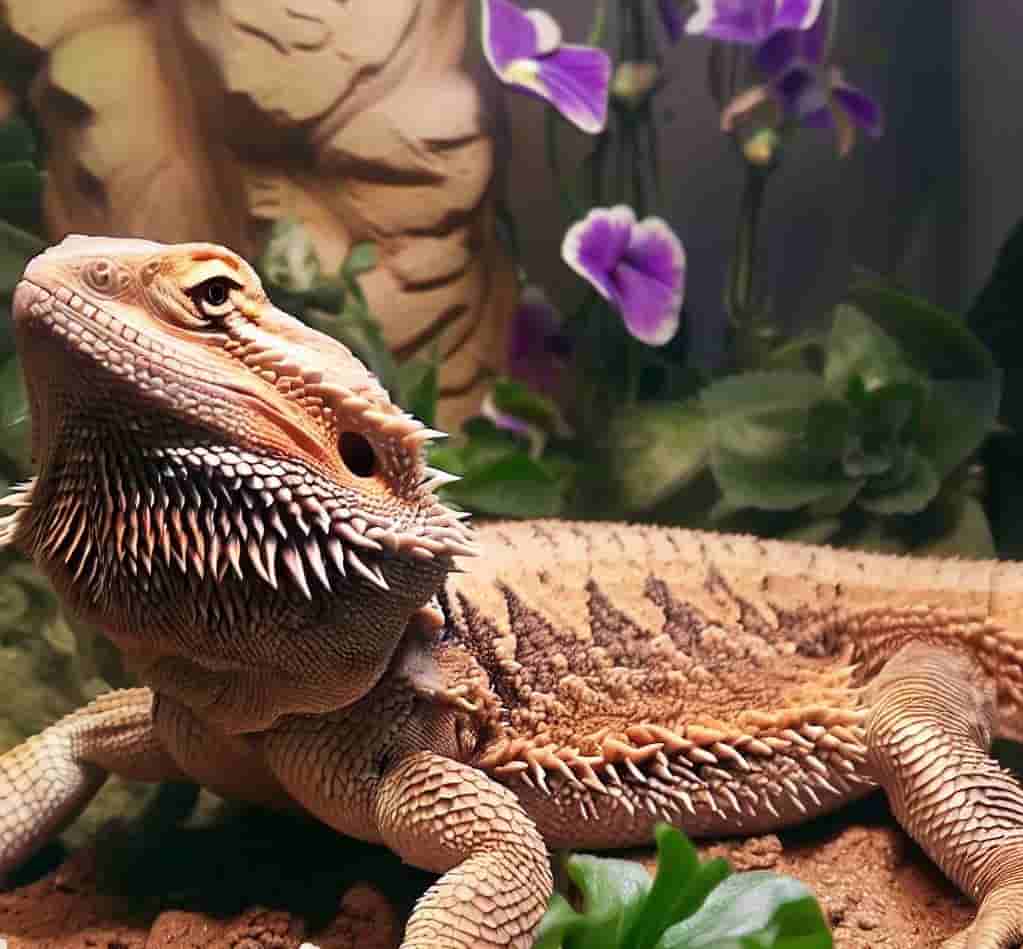
Petunias, with their trumpet-shaped flowers and wide range of colors, can add a dash of beauty to your pet’s habitat. Though they’re not typically a dragon’s first choice for a snack, they are safe if your pet decides to taste them.
Violas (Viola spp.)
Violas are small, vibrant flowers that can thrive in various conditions. Their flowers and leaves are also safe for your bearded dragon, offering an occasional treat.
Zinnias (Zinnia spp.)
Zinnias loved for their bright and diverse colors, can add a pop of hue to your dragon’s home. They’re easy to grow and, more importantly, safe for your pet.
Calendula (Calendula officinalis)
Calendulas, or pot marigolds, offer bright yellow and orange flowers that can brighten up your pet’s enclosure. They’re hardy, easy to care for, and safe for your bearded dragon.
Geraniums (Pelargonium spp.)
Geraniums offer a classic look with their rounded, brightly colored flowers. They are sturdy plants that can survive in the same conditions as your bearded dragon and are completely safe.
Sunflowers (Helianthus annuus)
Finally, sunflowers, though a bit larger, can make a striking addition to a spacious enclosure. The vibrant yellow petals and large flower heads can create a sunny, cheerful atmosphere. Plus, they’re safe if your bearded dragon decides to have a taste.
Climbing/Trailing Plants
To mimic a bearded dragon’s natural habitat, the enclosure should not only consist of ground-dwelling plants but also climbing and trailing varieties. These plants provide vertical elements and can serve as a lush background, providing a visually enriched environment and places to climb and explore.
Let’s look at a few safe and suitable options.
Creeping Fig (Ficus pumila)
Creeping Fig is a popular choice for climbing and trailing plants. Its tiny heart-shaped leaves and swift growth pattern make it ideal for covering the backdrop of your bearded dragon’s enclosure.
It’s also tough and adaptable, handling the hot and dry conditions of a bearded dragon’s habitat quite well. Moreover, if your bearded dragon shows an interest in munching on it, this plant is safe to eat.
Pothos (Epipremnum aureum)
Pothos, also known as devil’s ivy, is a visually appealing plant with its vibrant green, heart-shaped leaves. It’s hardy, adaptable, and thrives in a wide range of lighting conditions.
Despite being safe for your pet to crawl on, it should be noted that this plant is not edible for bearded dragons.
Spider Plant (Chlorophytum comosum)
The Spider Plant is another great option, known for its arching leaves and tiny plantlets that dangle down like spiders on a web.
They’re hardy and quick-growing, perfect for adding height to the enclosure. They’re also safe for your bearded dragon, both as a climbing structure and an occasional snack.
Wandering Jew (Tradescantia zebrina)
The Wandering Jew, with its purple and silver striped leaves, brings color and texture to the enclosure. It’s a fast-growing climbing plant that can quickly cover a backdrop or drape down from a height.
While it’s safe for your bearded dragon to climb on, it should be considered off-limits as a food source.
Passionflower (Passiflora spp.)
Passionflower, with its exotic-looking blooms and trailing growth habit, can add a touch of the tropics to your bearded dragon’s habitat.
These plants are non-toxic and can offer your dragon a climbing challenge, but it’s recommended that the fruits are removed if they appear, as they may not be suitable for your dragon to eat.
Jasmine (Jasminum spp.)
Jasmine plants are not just beautiful; they also provide a fragrant aroma. The sturdy vines of a jasmine plant are great for climbing, and their non-toxic nature makes them safe to include in your dragon’s enclosure.
The aromatic flowers can stimulate your pet’s senses, but remember to limit your bearded dragon’s intake to occasional nibbles.
Foliage Plants
Foliage plants are characterized by their vibrant greenery and are typically chosen for the lush, verdant appearance they bring to an environment. These plants can significantly enrich the aesthetic of a bearded dragon’s enclosure, giving it a tropical, lush vibe while providing your pet with a more naturalistic living space.
Bamboo (Bambusoideae)
Bamboo is a classic choice for creating an oriental feel in your bearded dragon’s enclosure. It’s a sturdy plant that offers climbing support, and its tall, segmented stalks can create a jungle-like atmosphere.
While bamboo is not a typical food source for bearded dragons, it’s non-toxic and safe if your pet decides to nibble on it.
Coleus (Plectranthus scutellarioides)
Coleus, with its bright, variegated leaves, brings color and vibrancy to an enclosure. This plant can thrive in a bearded dragon’s habitat under warm temperatures and UV lights.
Despite its visual appeal, coleus is not edible for your pet, so watching any attempted munching is best.
ZZ Plant (Zamioculcas zamiifolia)
The ZZ Plant, characterized by its waxy, dark green leaves, is a robust plant known for its high tolerance to various lighting conditions and relatively infrequent watering needs.
However, this plant should only be used for decorative purposes, as it is unsuitable for consumption.
Areca Palm (Dypsis lutescens)
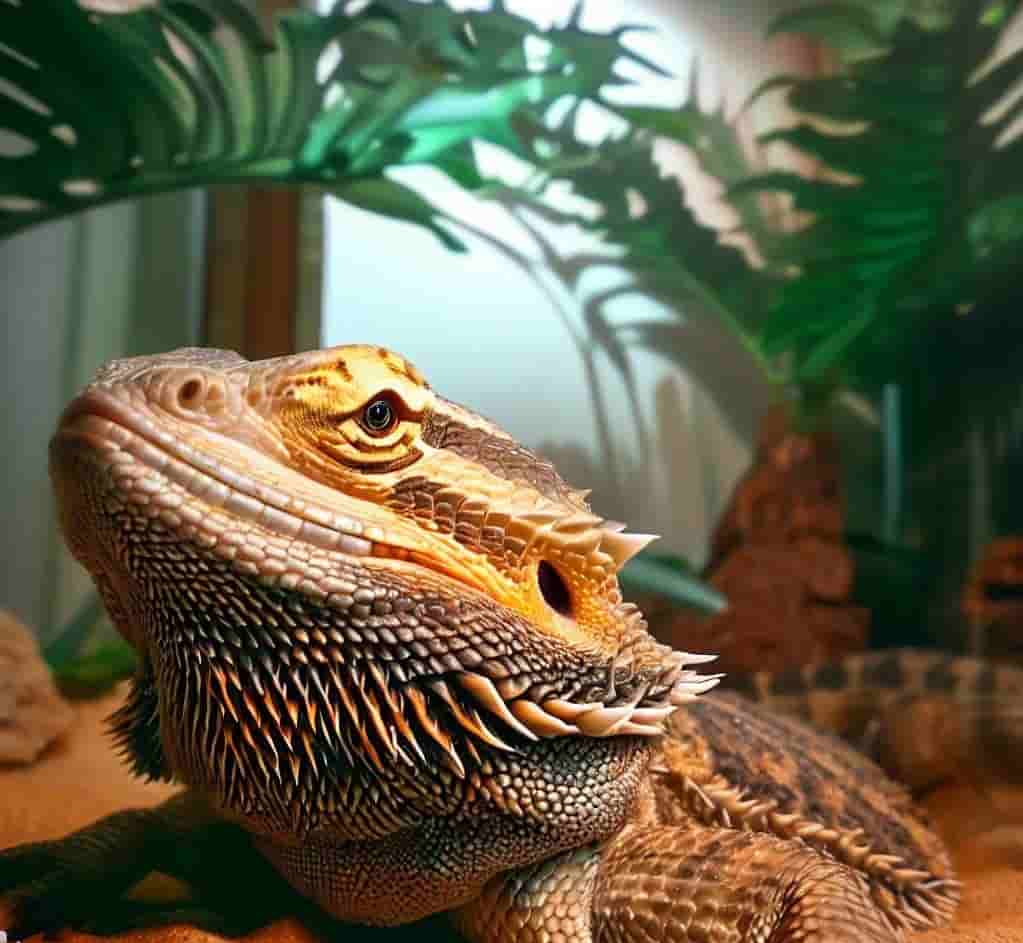
Areca Palms add a touch of the tropics to your bearded dragon’s enclosure. These palms are non-toxic and provide an attractive and sturdy climbing structure.
However, they require good lighting and humidity conditions to thrive, which may need to be balanced against your bearded dragon’s needs.
Rubber Plant (Ficus elastica)
Rubber Plants add a dramatic flair to the enclosure with their broad, glossy leaves. While they can endure the warm conditions of a bearded dragon’s habitat, it’s important to note that these plants are not edible and should be kept out of your pet’s reach if they habitually nibble on foliage.
Prayer Plant (Maranta leuconeura)
The Prayer Plant is a visually appealing option with its striped, folding leaves. It’s safe for bearded dragons but is typically enjoyed more for visual interest than taste. This plant prefers lower light levels, so it may need to be placed in a cooler part of the enclosure.
Ponytail Palm (Beaucarnea recurvata)
The Ponytail Palm, with its bulbous trunk and cascading leaves, can make a visually striking addition to an enclosure. It’s a slow-growing, drought-resistant plant that can withstand the arid conditions of a bearded dragon’s habitat.
While not a typical food source, it’s non-toxic if your pet does take a nibble.
Dracaena (Dracaena spp.)
Dracaenas, with their strappy leaves and woody stems, can add height and texture to your dragon’s enclosure. They’re non-toxic and safe for your pet to climb on, but they should be off the menu due to their slightly bitter taste.
Spider Plant (Chlorophytum comosum)
Spider plants are a repeat favorite in the reptile community. They’re quick-growing and add a touch of greenery. They are safe for your bearded dragon, both for climbing and as a snack, but should only be consumed in moderation.
Edible Plants
Edible plants, those that your bearded dragon can safely consume, play a crucial role in providing essential nutrients to their diet. Incorporating a variety of these plants not only stimulates their natural foraging behaviors but also adds visual appeal to their enclosure.
Squash (Cucurbita spp.)
Squash, such as butternut or spaghetti squash, can be grown in your bearded dragon’s enclosure for its vivid colors and texture. It’s a nutrient-rich food source that can be safely consumed when peeled and cut into manageable pieces for your pet.
Bell Peppers (Capsicum annuum)
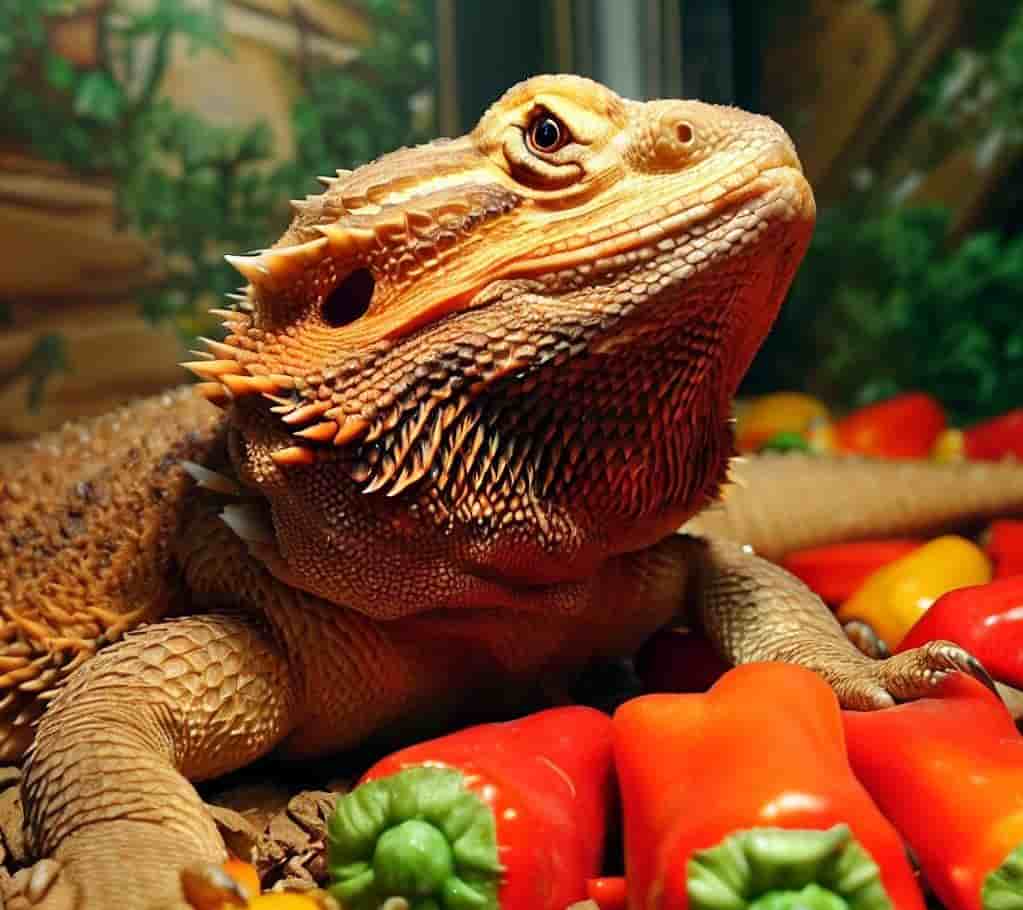
Bell Peppers, with their bright colors and crunchy texture, can be a delightful addition. They provide a rich source of vitamins A and C. However, they should be offered sparingly due to their high water content.
Carrots (Daucus carota)
Carrots can add a pop of color and are rich in beta-carotene, an important source of Vitamin A. The green tops are also edible and offer a nice texture variation. However, due to their high Vitamin A content, moderation is key to preventing hypervitaminosis.
Green Beans (Phaseolus vulgaris)
Green beans are another great option. They offer a crunchy texture and provide a good source of fiber. Remember to cut them into suitable sizes to prevent choking.
Snap Peas (Pisum sativum var. macrocarpon)
Snap peas are a crunchy and tasty treat for your bearded dragon. They provide an excellent source of Vitamin C, but due to their high phosphorus content, they should only be offered occasionally.
Hibiscus Flowers (Hibiscus spp.)
Hibiscus flowers are a delightful and favorite treat for many bearded dragons. They are not only beautiful additions to the enclosure but also provide a great source of antioxidants.
Nasturtium Flowers (Tropaeolum majus)
Nasturtiums are another edible flower that can brighten your bearded dragon’s enclosure. The bright blooms are safe for consumption and can be a fun and enriching snack for your pet.
Dandelion Flowers (Taraxacum officinale)
Dandelions are not just a common weed but a nutritious edible plant. Both the yellow flowers and green leaves are safe for your bearded dragon, offering a great source of calcium and vitamins.
Clover (Trifolium spp.)
Clover, both the leaves and the flowers, can be a tasty treat for your pet. They’re safe for consumption and offer an excellent source of vitamins.
Raspberry Leaves (Rubus spp.)
Raspberry leaves are another option. While the fruit should be offered sparingly due to its high sugar content, the leaves are a great source of fiber and safe for regular consumption.
20 Plants You Should Avoid
While many plants can safely coexist with your bearded dragon, there are several that can pose significant health risks. Below, we will discuss a list of plants that should never find their way into your bearded dragon’s enclosure due to their toxicity.
Amaryllis (Amaryllis spp.)
Amaryllis plants are toxic to many animals, including bearded dragons. Their bulbs are particularly harmful.
Azalea (Rhododendron spp.)
If ingested, Azalea contains grayanotoxins, which can cause serious health issues in bearded dragons.
Calla Lily (Zantedeschia spp.)
Calla Lilies contain calcium oxalates which can lead to calcium deficiency and potentially harm your bearded dragon.
Chrysanthemum (Chrysanthemum spp.)
Due to their pyrethrin content, chrysanthemums are toxic to many pets, bearded dragons included.
Daffodil (Narcissus spp.)
Daffodils, especially their bulbs, contain harmful alkaloids which are toxic to bearded dragons.
Dieffenbachia (Dieffenbachia spp.)
Dieffenbachia, also known as Dumb Cane, contains calcium oxalate crystals that can cause severe oral irritation.
Elephant Ear (Colocasia spp.)
Elephant Ears are toxic due to their high concentration of oxalate crystals, which can cause serious health issues if ingested.
English Ivy (Hedera helix)
If consumed, English Ivy contains saponins, which can cause significant health concerns for your bearded dragon.
Philodendron (Philodendron spp.)
Philodendrons contain poisonous calcium oxalate crystals, which can lead to health issues for your bearded dragon.
Poinsettia (Euphorbia pulcherrima)
Although often considered only mildly toxic, Poinsettias contain a sap that can be harmful to bearded dragons.
Snake Plant (Sansevieria spp.)
Snake Plants contain saponins, which can cause an upset stomach in bearded dragons if ingested.
Sago Palm (Cycas revoluta)
Sago Palms are extremely toxic. Even a small amount can result in significant health issues, including liver failure, in bearded dragons.
Yew (Taxus spp.)
Yews contain a compound called taxine, which is harmful to most pets, including bearded dragons.
Oleander (Nerium oleander)
Oleander is highly toxic to most pets. It contains compounds that can disrupt the heart’s rhythm if ingested.
Lily of the Valley (Convallaria majalis)
Lily of the Valley contains cardiac glycosides, which can cause heart problems in bearded dragons.
Mistletoe (Phoradendron spp.)
Mistletoe contains several toxic compounds that can harm your bearded dragon, including viscotoxins and phoratoxins.
Peace Lily (Spathiphyllum spp.)
Peace Lily contains calcium oxalates, which can cause oral irritation, excessive drooling, and other health problems in bearded dragons.
Tulip (Tulipa spp.)
Tulip bulbs contain toxic compounds that can harm bearded dragons, causing digestive issues and loss of appetite.
Hyacinth (Hyacinthus spp.)
Similar to tulips, the bulbs of hyacinths are harmful to bearded dragons due to the presence of toxic alkaloids.
Lily (Lilium spp.)
Many lilies are highly toxic to pets. They contain various toxic compounds that can cause kidney damage; even a small amount can be fatal.
Care for Your Bearded Dragon Safe Plants
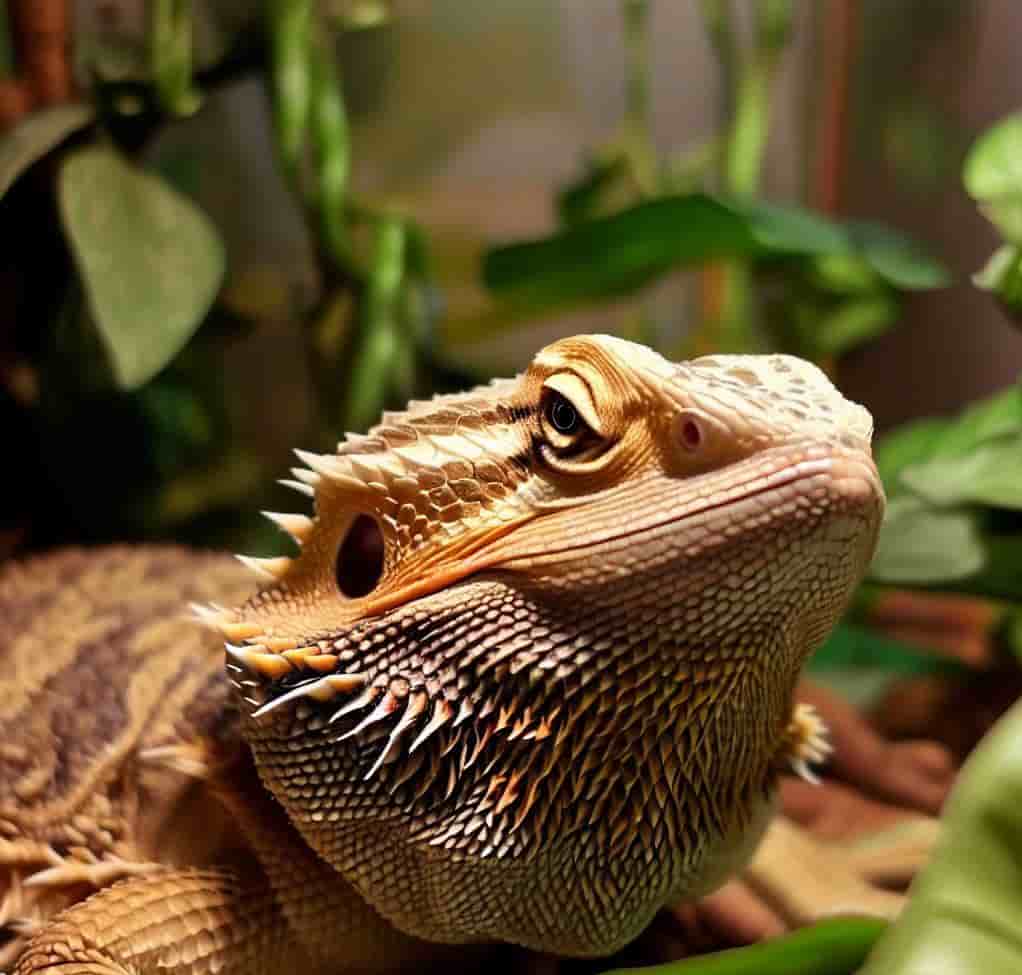
Maintaining the plants in your bearded dragon’s enclosure requires mindful strategies, much akin to traditional gardening.
Choosing the Right Potting Soil and Containers
Select a natural, pesticide-free potting mix, ensuring no toxic chemicals can leach into the soil and harm your dragon. The containers should provide ample space for plant growth and good drainage to prevent waterlogging.
Selecting a Sun Exposure Location
Choose a location that receives plenty of natural sunlight, replicating the natural environment of a bearded dragon. This will benefit both the plants and your pet.
Watering
Avoid overwatering. It’s crucial to strike a balance, ensuring plants are well-hydrated without creating excessive humidity, which can harm your dragon.
Pruning and Trimming Techniques
Regular pruning and trimming keep the plants manageable and healthy, preventing them from overcrowding the enclosure or obstructing light.
Fertilizer Requirements
Finally, feed the plants with organic, pet-safe fertilizers, avoiding chemical-rich ones that could potentially harm your bearded dragon.
Conclusion
In conclusion, selecting safe and diverse plants, such as those recommended in guides about safe plants for bearded dragons, is key to creating a harmonious environment for your bearded dragon. You can enhance their overall health and happiness with mindful care and attention.
Embrace these strategies and choices to cultivate an engaging and aesthetically pleasing enclosure where your dragon can thrive.
FAQs
How can I introduce plants into my bearded dragon’s enclosure without causing stress?
Introduce new plants gradually, ensuring they are non-toxic, properly cleaned, and placed in a way that doesn’t obstruct the dragon’s movement.
Do bearded dragons interact with plants in their enclosure, and if so, how?
Bearded dragons can interact with plants by using them for shade, climbing, or sometimes nibbling, so ensure they are sturdy and safe.
What factors should I consider when choosing bearded dragon safe plants?
When selecting bearded dragon safe plants, it’s crucial to ensure that the plant is non-toxic and safe for your pet. Your bearded dragon’s safety should always be your top priority.
How often should I replace the plants in my bearded dragon’s enclosure?
The frequency of replacing plants varies, but generally, it should be done when they start to wilt or show signs of damage.
Alina Hartley is a small-town girl with a ginormous love of bearded dragons. It all started with Winchester, a baby bearded who was abandoned at the shelter by his former owners because of a birth defect that caused one front leg to be shorter than the other. Alina originally went to the shelter looking for a guinea pig, but one look at Winchester and it was love at first sight. From that day on, Alina has dedicated her life to learning everything she can about bearded dragons. She loves helping new beardie parents start their incredible journey with these magnificent reptiles.
Follow her on:
LINKEDIN
TWITTER.
Read her latest articles HERE
Learn more about her HERE.

